

by Keavin Wiggins

.“Sing
me a song, you're the singer....”
 Whether he goes down as the “Man on the Silver Mountain,” the sinner who
sang us a song, “The Last In Line,” The Killer of the Dragon or the “Holy
Diver,” Ronnie James Dio has definitely earned his place in the history
books of rock n roll as a metal legend.
Whether he goes down as the “Man on the Silver Mountain,” the sinner who
sang us a song, “The Last In Line,” The Killer of the Dragon or the “Holy
Diver,” Ronnie James Dio has definitely earned his place in the history
books of rock n roll as a metal legend.
Even to this day, he continues to win over
new generations of metalheads with the wealth of material he has produced
over the years. With the sad news that Dio had lost his battle with stomach
cancer on Sunday morning (May 16th, 2010), we thought it only fitting to
rerun this Legends feature from 2003 as a tribute to the man and his talent.
 Ronnie James Dio was born Ronald James Padovona in New England, on July
10, (1949 or 1942 depending on the source). Like a lot of children of the post World War II era, he grew
up with the backdrop of Rock n Roll as the soundtrack to his adolescence.
Ronnie took to music right away and began his pursuit as a performer at
a young age, playing bass guitar and the trumpet in one of his early bands
The Vegas Kings. Like most rock stars to be, Ronnie cut his teeth
with a handful of different bands before settling down into the one that
would give him his first big break. In the late 60’s he was playing
with a band called the Electric Elves, who composed rock and folk music
that was the style of the time. By the dawn of the new decade the band
had changed their name to Elf and Ronnie was now going by the name Ronnie
Dio. They caught a lucky break when Deep Purple’s Roger Glover and Ian
Paice caught the band during an audition for Columbia records. With a record
deal in place Glover and Paice signed on to produce the band’s self-titled
debut album.
Ronnie James Dio was born Ronald James Padovona in New England, on July
10, (1949 or 1942 depending on the source). Like a lot of children of the post World War II era, he grew
up with the backdrop of Rock n Roll as the soundtrack to his adolescence.
Ronnie took to music right away and began his pursuit as a performer at
a young age, playing bass guitar and the trumpet in one of his early bands
The Vegas Kings. Like most rock stars to be, Ronnie cut his teeth
with a handful of different bands before settling down into the one that
would give him his first big break. In the late 60’s he was playing
with a band called the Electric Elves, who composed rock and folk music
that was the style of the time. By the dawn of the new decade the band
had changed their name to Elf and Ronnie was now going by the name Ronnie
Dio. They caught a lucky break when Deep Purple’s Roger Glover and Ian
Paice caught the band during an audition for Columbia records. With a record
deal in place Glover and Paice signed on to produce the band’s self-titled
debut album.
Looking back, the music of Elf wasn’t what
we would later come to expect from Dio. The group fell more easily into
the 60’s/70’s rock vibe of the harder edged material from the Rolling
Stones than Black Sabbath or Led Zeppelin, but one element stuck out even
from the beginning; Ronnie’s strong and unique vocals.
 With an album release under there belt, Elf hit the road with Deep Purple.
But for some reason, the band never really took off commercially. There
were also changes underway within the band at that point. Original guitarist
David Feinstein was replaced by Steve Edwards and Ronnie wanted to give
his full attention to his vocals, so the group brought in a new member
to handle bass duties, Craig Gruber.
With an album release under there belt, Elf hit the road with Deep Purple.
But for some reason, the band never really took off commercially. There
were also changes underway within the band at that point. Original guitarist
David Feinstein was replaced by Steve Edwards and Ronnie wanted to give
his full attention to his vocals, so the group brought in a new member
to handle bass duties, Craig Gruber.
With the lineup in place in 1974, Elf,
who had been released from their deal with Columbia, signed a new deal
in the US with MGM Records and with Deep Purple’s label Purple Records
in the U.K. In early 1974 the band traveled to England to record their
second album and once again Roger Glover handled production duties and
the band’s sound started to go more in the direction of Deep Purple.
That album hit in late 1974 entitled “Carolina
Country Ball” in the UK and “L.A. / 59” in the U.S. Once again Elf hit
the road supporting Deep Purple in North America but also the U.K.
Ronnie and Elfs’ keyboardist Mickey Lee
Soule also branched out a bit and took part in Roger Glover's solo project
“Butterfly Ball And The Grasshopper's Feast”.
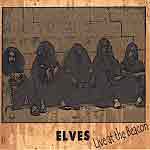 Over the next couple of years, Ronnie would divide his time between Elf
and participating in side projects. The full band went into the studio
to back Deep Purple guitarist Ritchie Blackmore on the single “Black Sheep
Of The Family”. A short time later, Blackmore contacted Dio to see if he
was interested in recording together again. That night Ronnie sat down
and wrote a new track called “Sixteenth Century Greensleeves”, and went
into the studio with Blackmore to record it.
Over the next couple of years, Ronnie would divide his time between Elf
and participating in side projects. The full band went into the studio
to back Deep Purple guitarist Ritchie Blackmore on the single “Black Sheep
Of The Family”. A short time later, Blackmore contacted Dio to see if he
was interested in recording together again. That night Ronnie sat down
and wrote a new track called “Sixteenth Century Greensleeves”, and went
into the studio with Blackmore to record it.
Nothing ever came of the song, which was
rumored to be intended as a b-side to the “Black Sheep of the Family” single.
But the seeds of partnership were planted between Ronnie and Ritchie Blackmore.
In early 1975 the band added percussionist
Mark Nauseef and returned to England to record their third album with Glover
once again producing. Shortly after the band finished recording the
album, they split up.
The group minus guitarist Steve Edwards
and percussionist Mark Nauseef, joined forces with Deep Purple’s Ritchie
Blackmore and formed Rainbow. At that point Ronnie supposedly began incorporating
his middle name into his stage name, at the suggestion of Blackmore.
 For marketing reasons, the group was originally dubbed Ritchie Blackmore’s
Rainbow. With Rainbow, Ronnie made the full transition to metal frontman.
The group entered a German recording studio in late February 1974 and emerged
three weeks later with their self-titled debut, which Blackmore and Dio
coproduced with Martin Birch. (Iron Maiden fans should recognize Birch’s
name.)
For marketing reasons, the group was originally dubbed Ritchie Blackmore’s
Rainbow. With Rainbow, Ronnie made the full transition to metal frontman.
The group entered a German recording studio in late February 1974 and emerged
three weeks later with their self-titled debut, which Blackmore and Dio
coproduced with Martin Birch. (Iron Maiden fans should recognize Birch’s
name.)
Unlike Elf, which never caught on commercially
in a big way, Rainbow was an instant hit. The single "Man on the Silver
Mountain," raced up the charts and put the group firmly on the map. UK
Elf fans hoping to get their hands on the third LP the band had completed
before splitting up were out of luck as the album was held back, so it
wouldn’t conflict with the release of “Ritchie Blackmore's Rainbow”.
The combination of Blackmore’s guitars
and Dio’s vocals made for a powerful frontline for Rainbow. But the duo
felt some changes were needed with the other members of the group. The
first member to be fired was bassist Craig Grubber, who was replaced by
Jimmy Bain and shortly afterwards Cozy Powell took over for drummer Gary
Driscoll.
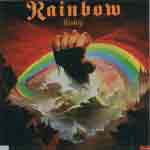 By the time the band hit the road in late 1975, the lineup had solidified
with keyboardist Tony Carey replacing Mickey Lee Soule. The band, which
at this point had shortened their name to just Rainbow, entered Musicland
studios in February of 1976 to record their sophomore album “Rainbow Rising”.
The album title seemed appropriate as the band’s fame and popularity was
going through the stratosphere, making them one of the most popular concert
draws of the day.
By the time the band hit the road in late 1975, the lineup had solidified
with keyboardist Tony Carey replacing Mickey Lee Soule. The band, which
at this point had shortened their name to just Rainbow, entered Musicland
studios in February of 1976 to record their sophomore album “Rainbow Rising”.
The album title seemed appropriate as the band’s fame and popularity was
going through the stratosphere, making them one of the most popular concert
draws of the day.
The group’s explosive live performance
was captured on the best selling live album, “On Stage,” which was released
in 1977. More lineup changes were in order for the group when they entered
the studio once again. This time they were joined by bassist Bob Daisley
and keyboardist David Stone to produce the critically acclaimed “Long Live
Rock'n'Roll”.
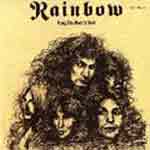 After the title track from the album became a big hit for the group, Dio
and Blackmore began to have intense disagreements over the direction of
the band. Blackmore wanted a more mainstream approach, while Dio wanted
to stay true to the original formula of the group. It all came to a head
in November 1978 when Blackmore reportedly fired the entire band, with
the exception of Cozy Powell. (some reports say that Dio quit).
After the title track from the album became a big hit for the group, Dio
and Blackmore began to have intense disagreements over the direction of
the band. Blackmore wanted a more mainstream approach, while Dio wanted
to stay true to the original formula of the group. It all came to a head
in November 1978 when Blackmore reportedly fired the entire band, with
the exception of Cozy Powell. (some reports say that Dio quit).
Ronnie didn’t have to wait long for a new
gig. While he was considering launching a solo project the dream gig fell
into his lap. Ozzy Osbourne had just been ousted from Black Sabbath and
Tony Iommi was looking for a replacement.
Ronnie had recently relocated to Los Angeles
and he was asked to visit Iommi’s Beverly Hills home to audition. Legend
has it that things went so well during that first visit with Iommi that
Ronnie wrote most of what was to become the classic “Children Of The Sea”,
at that session.
There is some speculation that the band
was originally going to be called Sabbath, since both Ozzy and Geezer Butler
were not involved. However, once Geezer came back, the group went back
to the full Black Sabbath name.
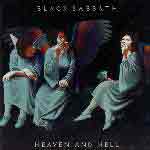 Filling the shoes of a legendary vocalist like Ozzy Osbourne is not easy
but Ronnie stood up to the challenge and together with his new band mates
produced what is arguably one of the best Black Sabbath albums ever released,
“Heaven And Hell”.
Filling the shoes of a legendary vocalist like Ozzy Osbourne is not easy
but Ronnie stood up to the challenge and together with his new band mates
produced what is arguably one of the best Black Sabbath albums ever released,
“Heaven And Hell”.
The fans and critics welcomed the change
and as a result the album was really successful. In the fall of 1980 Black
Sabbath teamed up with Blue Oyster Cult for a co-headlining North American
tour dubbed the “Black & Blue” tour.
The tour was major success with the exception
of a riot that occurred on October 9th, 1980 at Mecca Arena in Milwaukee.
After the band left the road they returned to the studio to begin recording
a new album, “Mob Rules”, with Vinnie Appice replacing Bill Ward on drums. 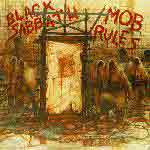
This album was again embraced by critics
and fans and continued the magic the group had produced together on “Heaven
and Hell”. But all was not well in Sabbath land. Infighting and bickering
began between the veteran members of the group and the newest members.
Things came to a head in October of 1982,
while the new live album, “Live Evil,” was being mixed by Geezer and Iommi.
Dio and Appice left the group to form 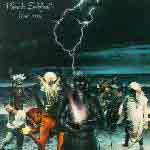 Dio’s solo band. Soon after, accusations began to fly that Dio and Appice
had secretly entering the studio and lowered the mix on the guitars and
bass. However, Iommi later rescinded those claims.
Dio’s solo band. Soon after, accusations began to fly that Dio and Appice
had secretly entering the studio and lowered the mix on the guitars and
bass. However, Iommi later rescinded those claims.
Dio and Appice recruited lead guitarist
Vivian Campbell and bassist Jimmy Bain to help complete their new group
which they called DIO.
Ronnie struck gold again with this group
and their debut album, “Holy Diver”, not only produced such classics as
“Rainbow In The Dark,” “Stand Up and Shout,” and of course the title track,
“Holy Diver,” it also firmly established Dio as a solo artist. 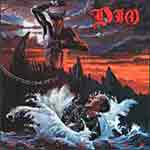
The fans ate it up, as the themes woven
by Ronnie in the songs on “Holy Diver” were familiar from his earlier work
and it also showed just how much influence he did have in songwriting with
his previous bands.
Dio crafted his new songs with a little
more commercial appeal, which opened a lot of doors to new fans. The relatively
new medium of MTV helped by showing videos for “Rainbow In The Dark” and
“Holy Diver”, and both songs, especially the former appealed to hard rock
radio programmers who helped expose Dio’s music beyond his built in audience
and that, along with a successful arena tour, propelled the album to platinum
sales.
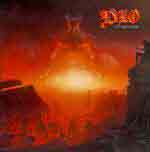 Dio wasn’t a band to rest on their laurels; they followed up their debut
a year later with “The Last In Line”. The demonic imagery of the album
cover translated well into the video for the title track and MTV jumped
all over it. Again, Dio managed to craft a true metal album that also had
a commercial appeal. By the time the second single, “Mystery”, had made
its run and the band had completed another arena tour, Dio was firmly established
as one of the leading metal bands of the era.
Dio wasn’t a band to rest on their laurels; they followed up their debut
a year later with “The Last In Line”. The demonic imagery of the album
cover translated well into the video for the title track and MTV jumped
all over it. Again, Dio managed to craft a true metal album that also had
a commercial appeal. By the time the second single, “Mystery”, had made
its run and the band had completed another arena tour, Dio was firmly established
as one of the leading metal bands of the era.
Dio got further propelled into the mainstream
spotlight in 1985 when they were asked to contribute a song to the “Vision
Quest” soundtrack. Madonna’s hit single from the album, “Crazy for You”,
inadvertently helped turn an even more mainstream audience onto Dio.
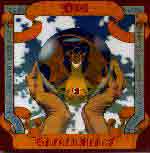 But that single couldn’t help Dio’s third album which was released shortly
afterwards. Dio had effectively avoided the “sophomore” slump with
“Last In Line” but the follow up album, “Sacred Heart” fell flat.
But that single couldn’t help Dio’s third album which was released shortly
afterwards. Dio had effectively avoided the “sophomore” slump with
“Last In Line” but the follow up album, “Sacred Heart” fell flat.
To many, “Sacred Heart” was a bit too commercial
and Dio abandoned the unifying themes of their first two albums.
The thematic elements used in the album were, to many critics, overdone.
The title track was an attempted epic at six and half minutes long that
had promising elements to it but seemed to fail in the execution. The single
“Rock 'N' Roll Children,” didn’t have the spark of earlier Dio hits and
sounded a bit too formulaic to hardcore fans.
 Dio’s fortunes would not change with their next effort. While the “Sacred
Heart” album sales were disappointing, Dio remained a big concert draw.
So the idea was hatched for a live EP that would feature one new studio
track.
Dio’s fortunes would not change with their next effort. While the “Sacred
Heart” album sales were disappointing, Dio remained a big concert draw.
So the idea was hatched for a live EP that would feature one new studio
track.
But there were some internal tension brewing
between Vivian Campbell and Ronnie. Rumors abound that Vivian claimed much
of the credit for the group’s success, saying he wrote half of the “Holy
Diver” album and it was his guitars that helped put the group on the map.
That didn’t sit well with the other members of the group and he was eventually
fired by Ronnie.
 The band needed a new axeman to record the song “Time to Burn” for the
live EP and they brought in Craig Goldie. Ronnie initially wanted to release
a full blown live album but the record company passed on the idea, instead
they opted for an EP. There was some speculation that Ronnie and the group
were not very happy with the final product and they showed that disdain
when they titled the EP, “Intermission”. The six song EP hit stores in
1986 but didn’t create much of a stir in metal circles.
The band needed a new axeman to record the song “Time to Burn” for the
live EP and they brought in Craig Goldie. Ronnie initially wanted to release
a full blown live album but the record company passed on the idea, instead
they opted for an EP. There was some speculation that Ronnie and the group
were not very happy with the final product and they showed that disdain
when they titled the EP, “Intermission”. The six song EP hit stores in
1986 but didn’t create much of a stir in metal circles.
The changes within the group and the lagging
sales seemed to reinvigorate Ronnie. When it came time to write music for
a new studio album, he had a lot to prove and needed to reestablish the
band as a group on the rise. The songs on 1987’s “Dream Evil” seemed
much more focused in their metal roots than “Sacred Heart”. Although the
album was not a huge commercial success, Dio managed to win back fans with
the skillfully crafted songs that showcased Goldie’s guitar hero credentials,
as well as Ronnie’s penchant for melody and thought evoking lyrics. 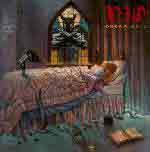
The single, “I Could Have Been A Dreamer”
also found success on radio, landing in the mainstream rock Top 40.
When it came time to tour behind the album, Dio pulled out all the stops
with their biggest stage production to date. But the tour was plagued with
misfortune from the very start. A broken down equipment truck led to a
six car pileup on a German highway. Roadies accidentally dropped
a $100,000 synthesizer while unloading gear for the European tour.
The band seemed to disintegrate following
the world tour. Goldie exited the band, followed shortly after by bassist
Jimmy Bain and keyboard player Claude Schnell.
 Ronnie conducted a massive search for a new guitarist. Over 500 audition
demos were sent in and whittled down to 20 candidates. One candidate
was a young guitarist by the name of Rowan Robertson. Robertson actually
attempted to audition for the band before they officially launched the
guitarist search. His audition tape was rejected but he really wanted
the gig so he managed to get a demo tape to Dio through the group’s fan
club and ultimately won the gig.
Ronnie conducted a massive search for a new guitarist. Over 500 audition
demos were sent in and whittled down to 20 candidates. One candidate
was a young guitarist by the name of Rowan Robertson. Robertson actually
attempted to audition for the band before they officially launched the
guitarist search. His audition tape was rejected but he really wanted
the gig so he managed to get a demo tape to Dio through the group’s fan
club and ultimately won the gig.
Dio got a lot of attention out of their
new guitarist because he was only 19 when the group began recording their
new album. But there were more shakeups in the making as drummer Vinny
Appice decided to leave the group at the end of 1989.
When the band entered the studio, Ronnie
was the only original member of his namesake group that now featured Simon
Wright(drums), Rowan Robertson(guitar) Jens Johansson(keys), and Teddy
Cook(bass).
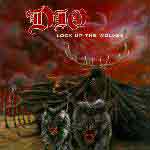 When “Lock up the Wolves” hit stores in 1990, diehard fans were relieved
that despite the personnel change, Dio hadn’t changed that much musically.
When “Lock up the Wolves” hit stores in 1990, diehard fans were relieved
that despite the personnel change, Dio hadn’t changed that much musically.
One night on the supporting tour would
prove fateful for Ronnie. When the “Throw 'em To The Wolves Tour” hit Minneapolis
on August 28th, 1990, little did fans know that the seed of a Black Sabbath
reunion would be planted when Geezer Butler joined Dio on stage for a jam
of “Neon Knights”.
The old chemistry between Ronnie and Geezer
seemed to be there and with one thing leading to another, Ronnie reunited
with Black Sabbath in early 1991 and put Dio on ice.
It took a few months for the band to fully
regroup. Original Sabbath drummer Bill Ward was not to be part of the project;
a project that the members emphatically told the press would be for only
one album and one tour.
 Initially Cozy Powell was brought in as the drummer but following a motorcycle
accident he was replaced by Vinny Appice in late 1991. With keyboardist
Geoff Nicholls rounding out the group, they entered the studio to record
a new album that was codenamed “Heaven and Hell II”. Before the actual
album shipped, dubbed “Dehumanizer” the group contributed one song, “Time
Machine,” to the Wayne’s World soundtrack and that lit the fire of expectations
in diehard fans.
Initially Cozy Powell was brought in as the drummer but following a motorcycle
accident he was replaced by Vinny Appice in late 1991. With keyboardist
Geoff Nicholls rounding out the group, they entered the studio to record
a new album that was codenamed “Heaven and Hell II”. Before the actual
album shipped, dubbed “Dehumanizer” the group contributed one song, “Time
Machine,” to the Wayne’s World soundtrack and that lit the fire of expectations
in diehard fans.
“Dehumanizer,” seemed to pick up where
“Mob Rules” left off, just a bit heavier. But it wasn’t the blockbuster
that was expected. It went on to sell a little over half a million copies
worldwide over the next few years.
More importantly, the personality divide
between the members with Ronnie and Vinnie on one side and Tony and Geezer
on the other doomed any plans for the group to continue on after the supporting
tour. It appeared that nothing had really changed during the decade they
had been apart and that divide would soon spell the end of the Black Sabbath
reunion.
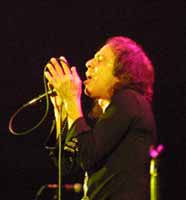 The final nail in the coffin came when Black Sabbath was invited to open
for Ozzy Osbourne for two dates in California. Ronnie reportedly didn’t
want to act as an opener for anyone, let alone the group’s original frontman
and told the other members of Sabbath that they were free to do whatever
they wanted but he would not perform at those shows.
The final nail in the coffin came when Black Sabbath was invited to open
for Ozzy Osbourne for two dates in California. Ronnie reportedly didn’t
want to act as an opener for anyone, let alone the group’s original frontman
and told the other members of Sabbath that they were free to do whatever
they wanted but he would not perform at those shows.
Ronnie’s contract with the band expired
on November 13th, 1992; the day before the first scheduled Ozzy date. Ronnie
took the opportunity to leave Sabbath and refocus his energy on Dio, taking
Vinnie along with him.
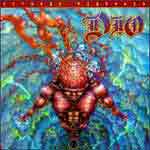 Dio reformed with bassist Jimmy Bain for a short time but he would ultimately
be replaced by Dokken’s Jeff Pilson. The band still had to fill that ever
important lead guitarist slot. Ads were place in Los Angeles area newspapers
and after a six month search, guitarist Tracy G was hired in time for the
band to record “Strange Highways”.
Dio reformed with bassist Jimmy Bain for a short time but he would ultimately
be replaced by Dokken’s Jeff Pilson. The band still had to fill that ever
important lead guitarist slot. Ads were place in Los Angeles area newspapers
and after a six month search, guitarist Tracy G was hired in time for the
band to record “Strange Highways”.
Before the group headed out on tour to
support their new album, Ronnie wanted to fill the vacant keyboardist slot.
Warrant’s Scott Warren would ultimately land the gig and has been a member
ever since.
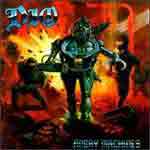 There would continue to be musical chairs in the bassplayer, drummer and
guitarist department over the next few years. Shortly after the “Strange
Highways” tour, Jeff Pilson left the group to rejoined Dokken and was replaced
by Jerry Best. Ironically, Best was only with the group a short time before
being replaced by Pilson, who rejoined the group to record a new album,
“Angry Machines”, which was produced by Ronnie.
There would continue to be musical chairs in the bassplayer, drummer and
guitarist department over the next few years. Shortly after the “Strange
Highways” tour, Jeff Pilson left the group to rejoined Dokken and was replaced
by Jerry Best. Ironically, Best was only with the group a short time before
being replaced by Pilson, who rejoined the group to record a new album,
“Angry Machines”, which was produced by Ronnie.
Due to his commitments to Dokken, Pilson
left the group prior to the “Angry Machines” tour and was replaced by Larry
Dennison.
 In February of 1998, Dio released “Inferno: Live In Line”, a double live
concert album that was hailed by critics as the definite live Dio experience.
The group managed to capture the extra energy they put forth in concert
and the album became the next best thing to seeing the group in person.
In February of 1998, Dio released “Inferno: Live In Line”, a double live
concert album that was hailed by critics as the definite live Dio experience.
The group managed to capture the extra energy they put forth in concert
and the album became the next best thing to seeing the group in person.
In May of 1998, Vinnie left the group to
rejoin Black Sabbath. Ronnie brought back Simon Wright, who has been with
the band ever since.
 It would take two years before fans would get their hands on a new studio
album from Dio. In that time, Craig Goldie and Jimmy Bain returned to the
Dio fold. The resulting album was the critically acclaimed “Magica”; a
dark concept album that revisited many of Ronnie’s medieval themes.
It would take two years before fans would get their hands on a new studio
album from Dio. In that time, Craig Goldie and Jimmy Bain returned to the
Dio fold. The resulting album was the critically acclaimed “Magica”; a
dark concept album that revisited many of Ronnie’s medieval themes.
Before the group returned to the studio
to record the follow up to “Magica”, Craig Goldie once again exited the
scene. Doug Aldrich stepped into his shoes and proved a powerhouse on the
2002 album, “Killing the Dragon”. That album showed that unlike many of
his contemporaries, Ronnie wasn’t about to kowtow to trends within the
heavy metal world. Through his entire career he has built up a certain
persona and style, and each subsequent album was built upon that foundation. 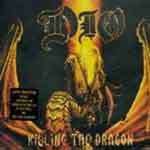 “Magica” and “Killing The Dragon” both proved that Ronnie hadn’t ran out
of steam and in fact continues to evolve as an artist, never letting his
long term fans down but also offering up compelling music for a new generation
whose contemporary metal heroes can’t begin to compare to the magic, music
and mystique of Dio.
“Magica” and “Killing The Dragon” both proved that Ronnie hadn’t ran out
of steam and in fact continues to evolve as an artist, never letting his
long term fans down but also offering up compelling music for a new generation
whose contemporary metal heroes can’t begin to compare to the magic, music
and mystique of Dio.
Fans both old and new were able to witness
that magic in action when Dio hit the road in support of Killing the Dragon
in 2002. Ronnie and crew blew away audiences at every stop on their headlining
tour in late 2002. And were also a force to be reckoned with a supporting
position on the joint Dio / Scorpions / Deep Purple tour during the summer
of 2002.
 During the summer of 2003, Dio took part in a “metal dream tour” that included
Motorhead and Iron Maiden. Three legendary bands that put metal on the
map assaulted North America all summer long and was a raging success, becoming
one of the busy summer concert season’s top draws.
During the summer of 2003, Dio took part in a “metal dream tour” that included
Motorhead and Iron Maiden. Three legendary bands that put metal on the
map assaulted North America all summer long and was a raging success, becoming
one of the busy summer concert season’s top draws.
It’s been over 30 years since Ronnie set
out on his rock n roll odyssey. During that time he has rocked generations
of metal heads with his patented voice and style. More importantly, he
has laid down a musical testament that most artists would have a hard time
topping. 50 years from now, rock historians will look at the metal
years of the late 20th century and early 21st century and Dio will stand
tall in their telling; not merely a footnote but a Legend in his own time…
and beyond.
RIP Ronnie James Dio

Info and Links

Legends: Ronnie James Dio
Preview
and Purchase This CD Online
Visit
the official homepage
More
articles for this artist
tell
a friend about this article
.

Live Photos by Keavin Wiggins
Copyright 2003 - All
Rights Reserved
...end |

